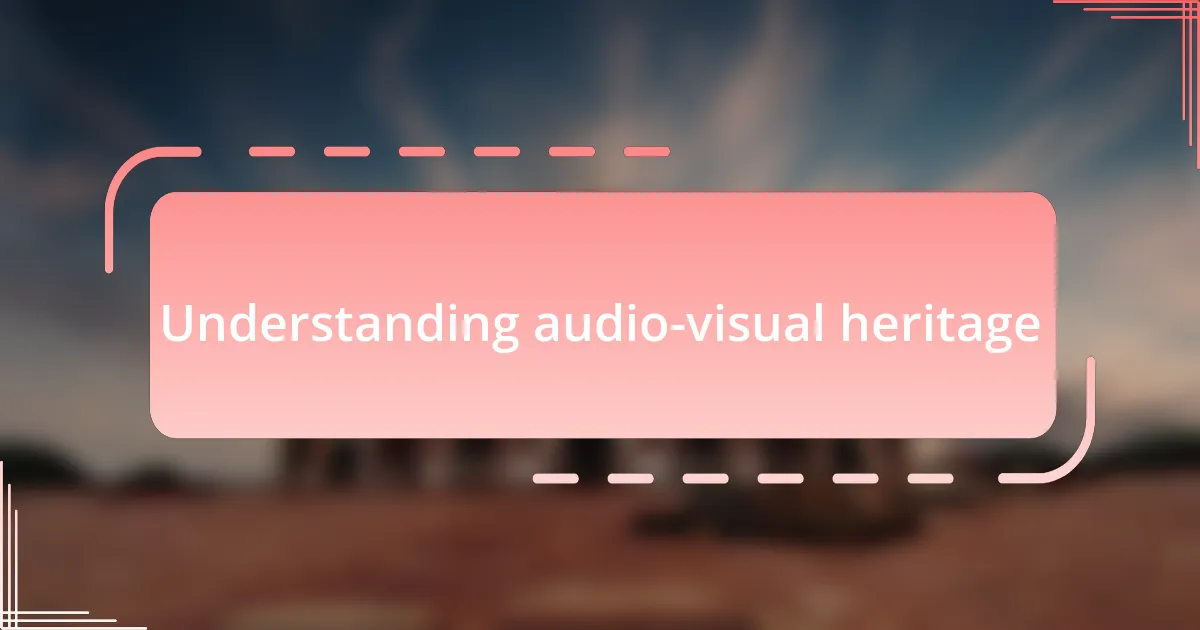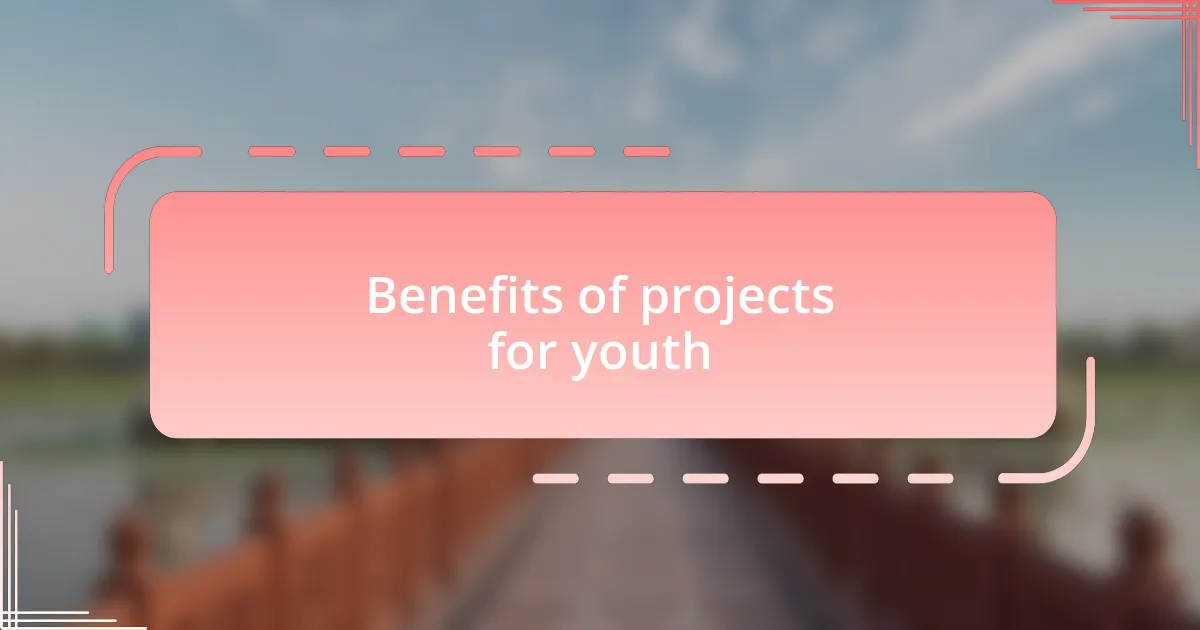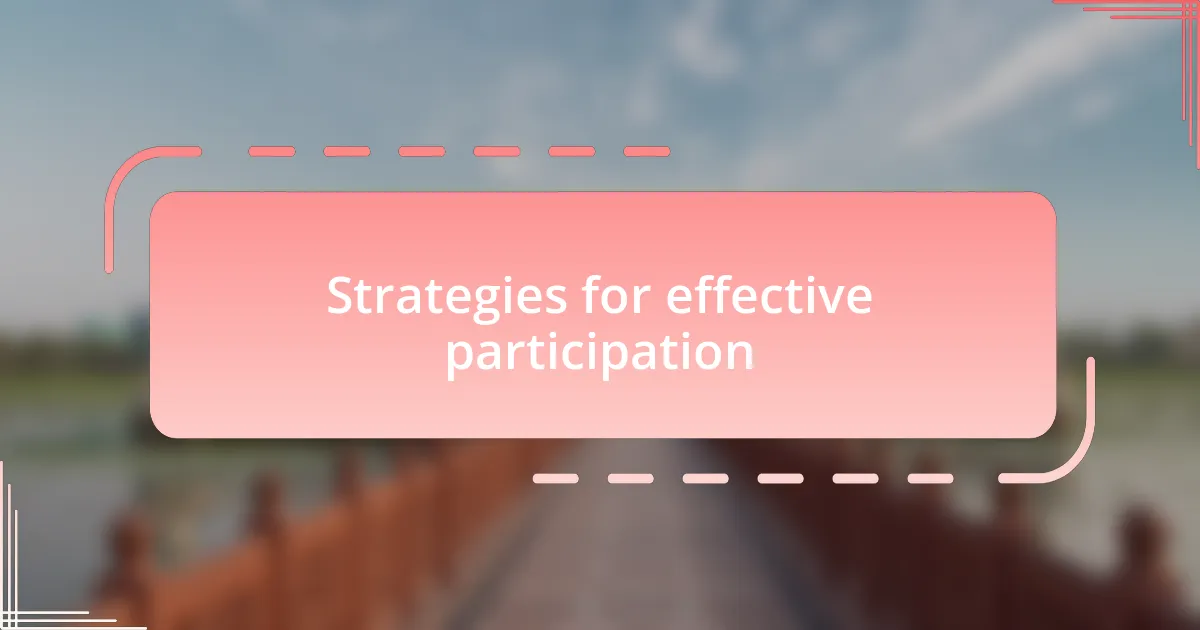Key takeaways:
- Audio-visual heritage is crucial for preserving culture and identity, allowing future generations to access their history.
- Engaging youth in heritage projects fosters ownership, creativity, and critical thinking while forming a vibrant community of advocates.
- Hands-on workshops, mentorship programs, and community competitions effectively involve youth and nurture their creative potential.
- A welcoming atmosphere and the use of social media can amplify youth voices and encourage their participation in projects.

Understanding audio-visual heritage
Audio-visual heritage refers to the vast array of materials that capture the sounds and images of our past, allowing us to experience history in a deeply immersive way. I remember watching old family videos; they reminded me of my grandparents’ stories and how they shaped our family’s narrative. Isn’t it fascinating how these recordings can evoke emotions and transport us back in time, bridging generations?
When I think about films, photographs, and recordings from significant moments in history, I realize they do more than just document events—they preserve culture and identity. Each piece is a time capsule, offering insights into the societal values of different eras. What would we lose if these treasures were forgotten, or worse, erased from existence?
Moreover, the preservation of audio-visual heritage poses challenges, especially in today’s fast-evolving technological landscape. I once attended a workshop where experts discussed the fragility of formats like VHS tapes. It struck me how easily these artifacts could deteriorate if not properly cared for. How important is it for us to take action now so that future generations can access their own history?

Importance of youth engagement
Youth engagement in projects related to audio-visual heritage is vital for several reasons. When young people participate, they bring fresh perspectives and energy that can revitalize efforts to document and preserve our shared history. I recall volunteering in a local archiving initiative, and seeing how my enthusiasm encouraged others to get involved. It’s a reminder that when youth feel invested, they don’t just contribute; they create a vibrant community of heritage advocates.
Moreover, engaging youth fosters a sense of ownership over cultural artifacts. They begin to understand the emotional significance behind the materials, which sparks their interest in storytelling and documentation. I once worked with a group of teenagers who shared their interpretations of historical events through short films. Watching them connect with the past and express their own narratives was incredibly powerful. Wouldn’t it be incredible if we could inspire more young people to see themselves as custodians of our culture?
Ultimately, the involvement of youth ensures that the narratives around audio-visual heritage continue to evolve. As they become stewards of their own history, they can bridge the gap between traditional preservation methods and innovative approaches that resonate with their peers. Have you noticed how youth-driven projects often garner more attention online? It’s a testament to the impact of their engagement on raising awareness and encouraging broader participation in heritage initiatives.

Benefits of projects for youth
Engaging youth in projects offers them invaluable opportunities for personal development. I remember a community event where young participants were tasked with creating a documentary about local history. Not only did they gain practical skills in film production, but they also developed confidence in their ability to communicate compelling narratives. Have you ever witnessed the transformation in someone when they realize their voice matters? It’s truly inspiring.
Participating in projects also fosters teamwork and collaboration among youth. During a project I led, the teens worked in groups to research different aspects of audio-visual heritage. Each member brought unique talents to the table—from writing and editing to filming and sound design. Seeing them learn to appreciate each other’s strengths felt like watching a symphony come together. Don’t you think collaboration lays the foundation for lifelong friendships and networks?
Moreover, such projects nurture critical thinking and creativity. When I guided a workshop that challenged youth to think about the future of audio-visual heritage, they proposed ideas that I’d never considered. It dawned on me that when young minds engage with complex topics, they often surprise us with their innovative solutions. Isn’t it exciting to think about what they can achieve when we give them the space to explore and express their ideas?

Approaches to involve youth
One effective approach to involve youth is through hands-on workshops that let them experiment with audio-visual tools. I once organized a weekend event where teenagers learned to edit their own short films using software typically reserved for professionals. Witnessing their excitement as they transformed raw footage into polished pieces was remarkable. Have you ever seen a young person light up when they realize they can create something meaningful? It’s that spark of creativity we should nurture.
Another method is to establish mentorship programs that connect youth with industry professionals. I remember when I paired a group of high school students with filmmakers who generously shared their insights and experiences. The students asked thoughtful questions and gained invaluable advice that boosted their self-esteem and aspirations. Don’t you think having a mentor can change the trajectory of a young person’s journey?
Additionally, hosting community competitions can serve as a motivational tool. I recall a local contest inviting youth to submit 60-second videos documenting their perspectives on heritage. The enthusiasm was contagious, and the finalists presented their stories in a local theater. Seeing their work appreciated by the community not only validated their efforts but also empowered them to continue creating. Isn’t it fascinating how a little recognition can fuel ambition?

Strategies for effective participation
Incorporating youth into projects effectively requires creating a welcoming atmosphere that encourages their ideas. I once facilitated a brainstorming session where young participants shared their visions for a community film festival. Their unexpected creativity and passion reminded me of how important it is to listen to their voices. Have you ever noticed how empowering it feels to contribute your thoughts to a group?
Another strategy is to utilize social media as a platform for engagement. When I launched an Instagram campaign that invited young people to share their audio-visual creations, I was blown away by the response. The energy was palpable as they took pride in showcasing their work, and the interaction fostered a sense of community among them. Isn’t it amazing how digital spaces can amplify youth voices in ways we’d never imagined before?
Lastly, providing opportunities for collaborative project development can harness their skills and foster teamwork. I’ve observed that when youth work together on a documentary project, they not only learn from each other but also form lasting friendships. Seeing them navigate challenges as a team reinforced my belief that collaboration can enhance their commitment and investment in the project. Don’t you think collaboration teaches invaluable life skills that extend beyond just the project at hand?

Personal experiences with youth projects
In my experience, engaging youth in projects often leads to unexpected insights. During a workshop on audio-visual storytelling, I remember a shy participant who surprised us all with a poignant short film that tackled mental health issues. Watching the room light up with understanding and empathy was a powerful reminder that young voices often express complex emotions in the most impactful ways. Have you ever witnessed a quiet individual emerge as a creative powerhouse?
Another memorable experience was organizing a community project where young people documented local history. Seeing them interact with elders to gather stories was heartwarming. It was as though they were bridging generational gaps, and the enthusiasm in their eyes as they brought those stories to life was contagious. Don’t you think it’s fascinating how such initiatives can connect different ages and cultures through shared narratives?
I also reflect on a mentorship program I led, where we paired high school students with professionals in the audio-visual field. The tension was palpable at first, but as they collaborated on a documentary, I saw their confidence grow dramatically. Their transformative moments revealed not only their potential but also the powerful impact a supportive environment can have on youth development. Doesn’t it leave you wondering what other talent is waiting to be unveiled with just a little encouragement?